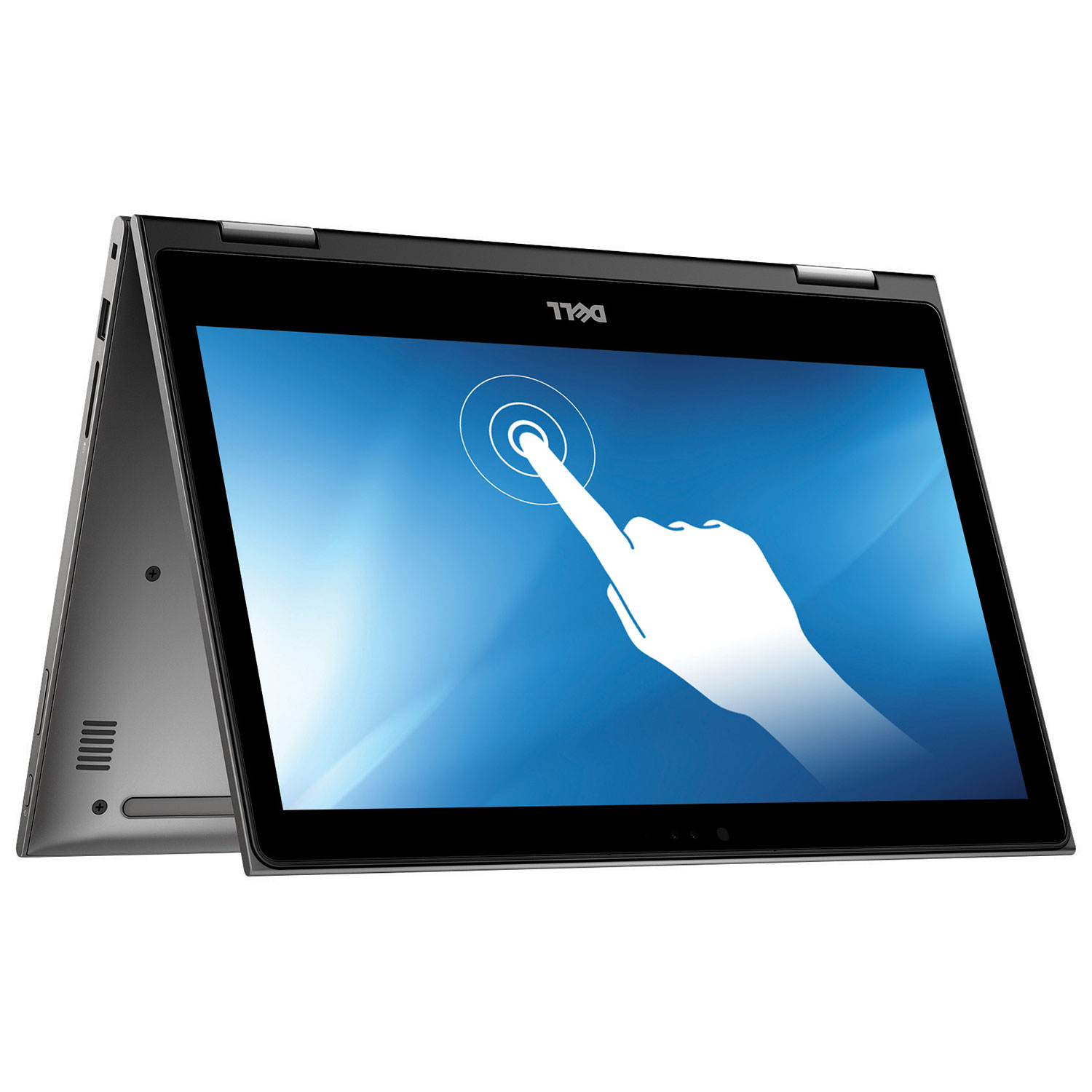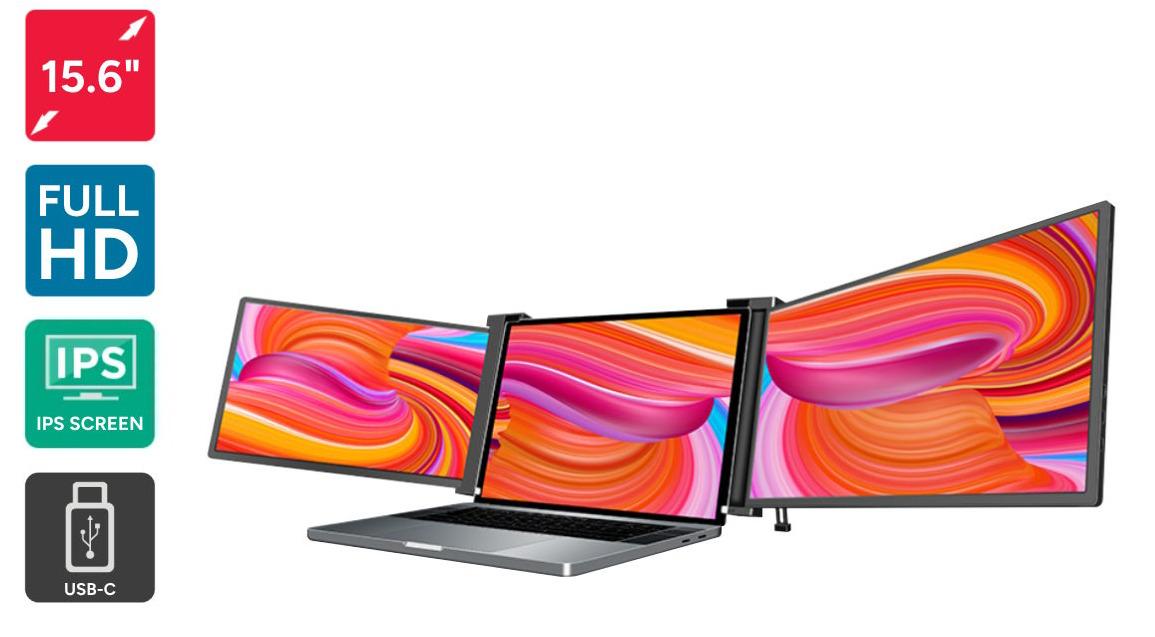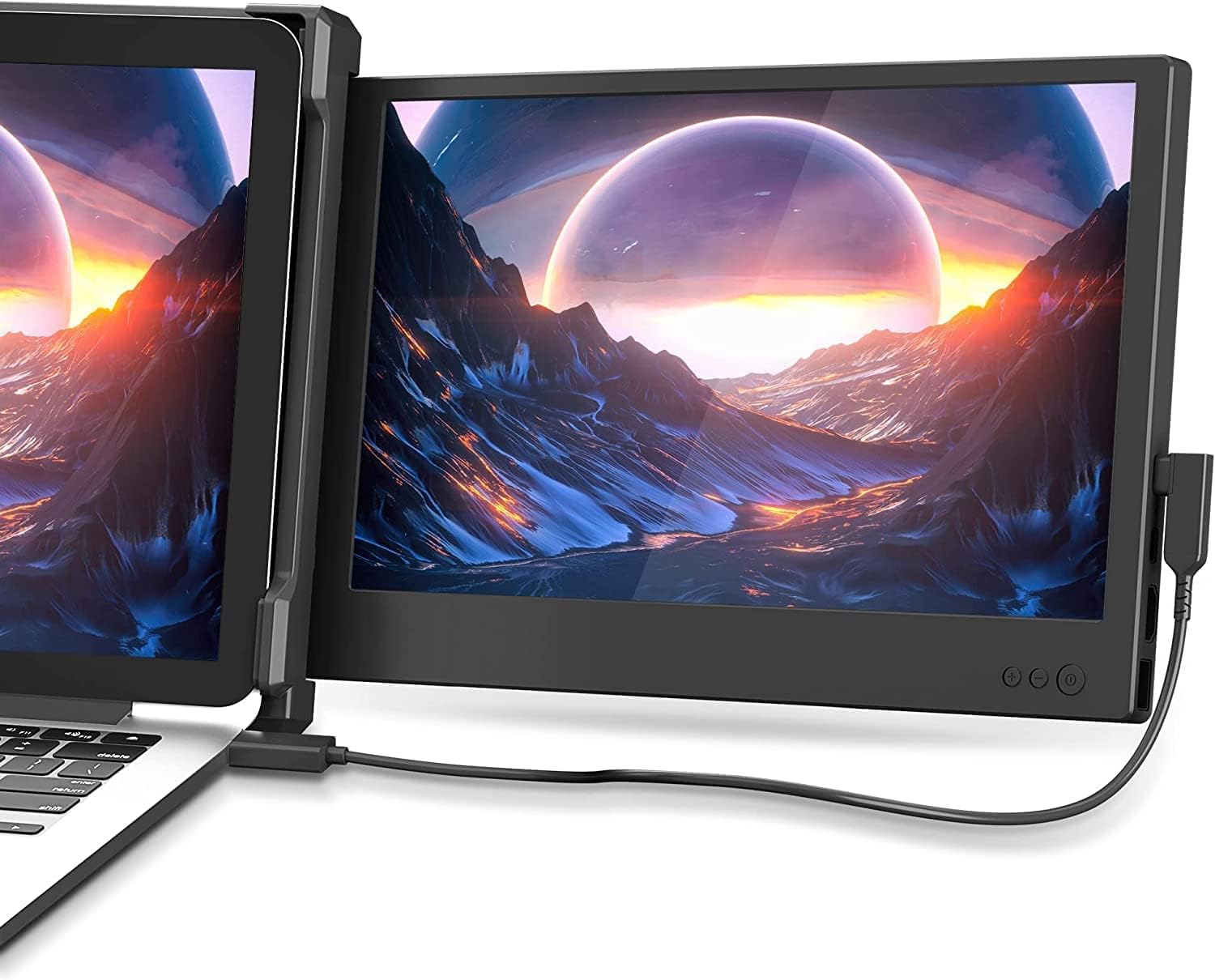🎯 Top 5 Must-Have Portable Monitors in 2025 🔥 Boost Your Productivity Anywhere!
Portable monitors have become an indispensable tool for modern professionals, travelers, and tech enthusiasts seeking enhanced productivity on the go. These compact devices offer a flexible way to extend your workspace, whether you’re working from a coffee shop or gaming during a layover. In this article, we’ll explore the best options for portable monitors, including recommendations tailored for laptops, travel, MacBook users, and coding setups, based on expert reviews and real-world testing.
ZUMWALT Laptop Screen Extender, 14" Triple Portable Monitor for Laptop, 1080P FHD Screen Extender Monitors for 13"-16.5" Laptop, Monitor Extender for MacOS/Windows/Chrome (Built-in Speakers)
$189.99
Features
- Product Dimensions: 13.85 x 8.5 x 1.44 inches
- Item Weight: 4.73 pounds
- Manufacturer: ZUMWALT
- ASIN: B0DZHQ4VNP
- Country of Origin: China
- Item model number: S3
- Best Sellers Rank: #2,118 in Electronics (See Top 100 in Electronics) #65 in Computer Monitors
- Date First Available: March 6, 2025
- Standing screen display size: 14 Inches
- Aspect Ratio: 16:9
- Resolution: 1920 x 1080 Pixels
- Image brightness: 300 NITS lm
Description
- Wide Compatibility & Application: ZUMWALT laptop screen extender monitor portable compatible with Mac/Windows/Android/Chrome/Switch via USB-C/HDMI. Triple portable laptop screen extender perfect for remote workers, home offices, online learning students, online meetings, gamers,...
Introduction to Portable Monitors

The world of portable technology is evolving rapidly, and portable monitors stand out as a game-changer for anyone needing extra screen real estate without the bulk of traditional displays. These sleek devices are designed to pair seamlessly with laptops, tablets, and even smartphones, providing a secondary screen that fits into your backpack. As remote work and digital nomadism continue to rise, the demand for reliable portable monitors has surged, with manufacturers focusing on lightweight builds, high-resolution screens, and versatile connectivity.
Before diving into the specifics, it’s worth noting that the best portable monitors aren’t just about specs; they’re about enhancing your daily workflow. From boosting multitasking capabilities to delivering immersive visuals for entertainment, these monitors cater to diverse needs. In the following sections, we’ll break down key aspects, helping you make an informed decision based on factors like portability, compatibility, and budget.
Definition and Purpose
Portable monitors are essentially lightweight, external displays that connect to devices like laptops or smartphones via USB, HDMI, or wireless options. Their primary purpose is to extend or mirror your main screen, allowing for better productivity in scenarios where space is limited. Unlike bulky desktop monitors, these are built for mobility, often weighing under 2 pounds and featuring protective cases for travel.
In today’s fast-paced environment, the purpose of a portable monitor goes beyond mere convenience. For digital nomads, it means turning a coffee shop table into a dual-screen workstation. Professionals use them to manage emails on one screen while working on documents on another, reducing eye strain and improving efficiency. According to recent trends, the rise of hybrid work models has made portable monitors essential for maintaining focus and creativity on the move.
Moreover, these devices serve creative professionals like graphic designers or coders by providing accurate color reproduction and ample screen space. The key is selecting a model that aligns with your lifestyle—whether it’s for quick setups in airports or extended use at home. With advancements in 2025, portable monitors now offer features like built-in batteries and eye-care technologies, making them more versatile than ever.
Key Features of Portable Monitors
One of the standout features of modern portable monitors is their display technology, such as IPS panels, which deliver wide viewing angles and vibrant colors. This ensures that content looks consistent from different perspectives, a must-have for collaborative settings or travel. Additionally, connectivity options like USB-C and HDMI allow for plug-and-play ease, minimizing setup time and compatibility issues.
Battery life is another critical feature, with some portable monitors offering up to 6 hours of independent operation, ideal for scenarios without easy access to power outlets. This is particularly beneficial for travelers or remote workers who might be in transit. Furthermore, features like anti-glare coatings and adjustable stands enhance user comfort, reducing fatigue during long sessions.
Beyond the basics, advanced portable monitors include built-in speakers, touch capabilities, and even smart integration with apps for productivity. For instance, if you’re eyeing options like the Dell P1424H, it boasts excellent color accuracy and dual USB-C connectivity, making it a top choice for reliability. These features collectively transform portable monitors from simple accessories into powerful tools that adapt to your needs.
Understanding Portable Monitors

Delving deeper into the realm of portable monitors, it’s clear that these devices are more than just portable screens—they’re a bridge to enhanced digital experiences. As technology advances in 2025, consumers are gravitating towards models that balance performance with practicality, especially for on-the-go use. This section explores the fundamentals, helping you grasp why portable monitors are becoming a staple in tech arsenals worldwide.
From their compact designs to innovative features, portable monitors address the growing need for flexibility in an increasingly mobile world. Whether you’re a student, professional, or gamer, understanding these devices can unlock new levels of efficiency and enjoyment. Let’s break it down further to uncover what makes them tick.
Definition and Purpose
At its core, a portable monitor is a secondary display that’s lightweight and easy to transport, typically ranging from 14 to 22 inches. Its purpose extends far beyond extending your laptop’s screen; it’s about creating a personalized workspace that travels with you. In 2025, with the surge in remote work, these monitors serve as vital tools for maintaining productivity without sacrificing quality.
For instance, imagine working in a bustling airport—portable monitors allow you to set up a dual-screen environment quickly, boosting your ability to multitask. They cater to various users, from business travelers needing to review presentations to creatives requiring precise color accuracy. The evolution of portable monitors has been driven by user feedback, emphasizing durability and ease of use in real-world settings.
Moreover, the purpose of portable monitors is evolving to include entertainment and gaming. With high-refresh-rate options, they offer smooth visuals for movies or esports, making them versatile for leisure. As we move forward, understanding this definition helps in appreciating how portable monitors integrate into daily life, providing a seamless blend of work and play.
ZUMWALT Laptop Screen Extender, 14" Triple Portable Monitor for Laptop, 1080P FHD Screen Extender Monitors for 13"-16.5" Laptop, Monitor Extender for MacOS/Windows/Chrome (Built-in Speakers)
$189.99
Features
- Product Dimensions: 13.85 x 8.5 x 1.44 inches
- Item Weight: 4.73 pounds
- Manufacturer: ZUMWALT
- ASIN: B0DZHQ4VNP
- Country of Origin: China
- Item model number: S3
- Best Sellers Rank: #2,118 in Electronics (See Top 100 in Electronics) #65 in Computer Monitors
- Date First Available: March 6, 2025
- Standing screen display size: 14 Inches
- Aspect Ratio: 16:9
- Resolution: 1920 x 1080 Pixels
- Image brightness: 300 NITS lm
Description
- Wide Compatibility & Application: ZUMWALT laptop screen extender monitor portable compatible with Mac/Windows/Android/Chrome/Switch via USB-C/HDMI. Triple portable laptop screen extender perfect for remote workers, home offices, online learning students, online meetings, gamers,...
Key Features of Portable Monitors
When evaluating portable monitors, key features like resolution and panel type play a pivotal role. Most modern models feature Full HD or higher resolutions on IPS panels, ensuring sharp images and consistent colors from any angle. This is particularly important for tasks like photo editing or coding, where accuracy is paramount.
Connectivity is another cornerstone feature; options such as USB-C enable fast data transfer and power delivery, often eliminating the need for separate adapters. For travelers, features like foldable designs and protective covers add to the appeal, safeguarding the device during transit. In 2025, we’re seeing an increase in monitors with built-in batteries, allowing for wireless use in environments like coffee shops.
Additionally, aspects like brightness and contrast ratios enhance the overall experience. A portable monitor with high brightness, such as the ASUS ZenScreen MB229CF, can handle outdoor use without washing out colors. These features not only improve visibility but also contribute to eye health, with technologies like blue light filters reducing strain during extended sessions.
Best Portable Monitor for Laptop

Pairing a laptop with a best portable monitor for laptop can dramatically enhance your workflow, turning a single-screen setup into a powerhouse of productivity. In 2025, as laptops become sleeker and more powerful, the need for an external display that matches this portability is more evident than ever. This section dives into why selecting the right portable monitor for your laptop is crucial, drawing from expert reviews and user experiences.
With the rise of remote work, a best portable monitor for laptop offers the flexibility to expand your digital canvas, whether you’re in an office or on the road. It’s not just about adding screen space; it’s about optimizing your setup for efficiency and comfort. Let’s explore the factors that make certain models stand out.
Factors to Consider
When choosing a best portable monitor for laptop, several factors come into play, starting with compatibility. Ensure the monitor supports your laptop’s ports, such as USB-C or HDMI, to avoid any connectivity hassles. Resolution and size are equally important; a Full HD display in the 14-17 inch range often strikes the perfect balance for laptop users.
Another key factor is weight and build quality. A lightweight model under 2 pounds is ideal for frequent travelers, while durable materials prevent damage from daily use. Price is also a consideration—options ranging from $100 to $500 can fit various budgets, but always weigh the cost against features like color accuracy and viewing angles.
Furthermore, think about power consumption. Some portable monitors draw power directly from your laptop, which can affect battery life, while others have their own power sources. User reviews often highlight how these factors impact real-world performance, making them essential for informed decisions.
Top Choices for Laptop Users
Among the top choices for a best portable monitor for laptop, the Dell P1424H emerges as a favorite due to its 14-inch Full HD IPS display and excellent color accuracy. This model, priced between $250 and $350, features dual USB-C connectivity, making it a seamless addition to most laptops. If you’re looking for reliability, the Dell P1424H is highly recommended—check it out on Amazon for more details: Dell P1424H.
Another strong contender is the ASUS ZenScreen MB229CF, with its 22-inch screen offering ample workspace for multitasking. At $300 to $400, it provides solid brightness and easy setup, ideal for professionals needing a larger display without sacrificing portability. Users praise its ability to handle demanding tasks like video editing on laptops.
For budget-conscious users, the Yoda 15.6-Inch Portable Monitor stands out, offering great value at $150 to $200. Its lightweight design and multiple connectivity options make it perfect for everyday laptop use, with positive feedback on its compact form.
User Reviews and Experiences
User reviews for the best portable monitor for laptop often emphasize the Dell P1424H’s manageable weight and optimal viewing angles, with many reporting enhanced productivity during long work sessions. One user shared, “It transformed my laptop setup into a dual-screen powerhouse, making remote work feel like office life.”
Experiences with the ASUS ZenScreen MB229CF highlight its suitability for presentations, with users appreciating the large screen for collaborative projects. However, some noted that in bright environments, the brightness could be pushed further.
Overall, the Yoda model’s affordability draws praise, with coders and students alike valuing its ease of use. As one reviewer put it, “It’s a game-changer for my laptop-based workflow, especially when traveling.”
Portable Monitor vs Second Screen

The debate between a portable monitor vs second screen often boils down to mobility versus permanence, with each option catering to different lifestyle needs. In 2025, as technology blurs the lines between work and travel, understanding these differences can guide your choice for optimal setup. This section weighs the pros and cons, helping you decide based on your specific scenarios.
While a portable monitor offers unmatched flexibility, a second screen might provide stability for home use. The key is evaluating how each enhances your daily routine, from boosting productivity to streamlining creative tasks.
Benefits of Each Option
A portable monitor shines in its benefits for on-the-go users, providing a lightweight alternative that can be packed away easily. Its primary advantage is versatility, allowing you to extend your laptop’s capabilities anywhere, which is ideal for best portable monitor for travel 2025.
On the other hand, a second screen, often a desktop monitor, benefits from larger sizes and higher resolutions, making it perfect for stationary setups. It typically offers better color accuracy for tasks like graphic design, without the compromises in portability.
Both options improve multitasking, but portable monitors edge out in scenarios requiring frequent relocation, while second screens excel in ergonomic, long-term use.
Use Cases for Portable Monitors
Portable monitors are best suited for dynamic environments, such as coffee shops or airplanes, where space is limited. For instance, a best portable monitor for laptop can turn a solo device into a dual-screen workstation, enhancing efficiency during business trips.
In professional settings, they’re used for quick presentations or remote meetings, with models like the LG 17 MT70 offering exceptional visuals for gamers and creators. This makes them acrucial tool for improving collaboration and engagement in a fast-paced work landscape.
Recommended Scenarios for Second Screens
Conversely, second screens are ideal for users who spend extended hours at a workstation, such as graphic designers or financial analysts. The bigger display area makes multitasking with multiple applications seamless, reducing the need to constantly switch between tabs. Users often find that having dedicated workspace leads to increased productivity, particularly when working with intensive software.
For those who utilize a second screen, consider connectivity options and adjustability, as these enhance comfort and usability. More permanent setups can include an adjustable desktop mount, providing flexibility to customize your viewing angle.
In summary, both portable monitors and second screens have their merits; the choice largely hinges on your working style and setup preferences. Assessing your personal needs will better inform your decision on which option suits you best.
$69.98
$109.98
Best Portable Monitor for Travel 2025

As travel resumes globally in 2025, finding a reliable best portable monitor for travel 2025 has become essential for those who work on the go. The right model must combine lightweight design with robust features to support productivity without adding extra bulk to your kit.
Essential Features for Travelers
When selecting a portable monitor for travel, prioritize features like weight, battery life, and connectivity. A monitor that weighs less than 2 pounds can easily fit into your laptop bag, while efficient battery life ensures you can work without being tied to an outlet, particularly on long-haul flights.
Connectivity options matter significantly; USB-C or HDMI compatibility offers versatility for various devices. Additionally, screens offering touch functionality can enhance user experience, making them more intuitive and user-friendly during quick setups.
Durability is another essential feature; a monitor that withstands the rigors of travel, such as bumps or spills, can save you from purchasing replacement devices frequently. Look for models with sturdy exteriors or protective cases to maintain longevity.
Top Portable Monitors for Travel
Among the top contenders for the best portable monitor for travel 2025, the ASUS ZenScreen MB16AC has gained a reputation for its slim profile and exceptional display quality. With a weight of just 1.76 pounds and Full HD resolution, it’s ideal for travelers prioritizing space and performance. Users commend its impressive battery life as it can function solely on USB power.
Another notable option is the Arzopa S1, which blends portability and affordability. This monitor weighs around 1.5 pounds, boasts an anti-glare screen for efficient outdoor usage, and ranges between $200-$250. It has garnered positive user reviews for its easy connectivity options and good color reproduction.
For those seeking high-resolution and quality, the LG 17 MT70 is lauded not just for its 17-inch display but also its exceptional visual fidelity, making it top-tier for creative professionals on the move. It’s slightly heavier but considered manageable for its capabilities.
User Testimonials
User feedback about the mentioned models often highlights how they enhance productivity while traveling. One traveler reported, “The ASUS ZenScreen completely transformed my workflow on business trips; I could finally present and collaborate without being tethered to the hotel desk.”
The Arzopa S1 receives praise for its budget-friendliness, with students and professionals alike finding it a suitable companion for on-the-go requirements. A recent user noted, “I was pleasantly surprised by the quality I got for the price.”
Lastly, the LG 17 MT70 elicits admiration from creatives, stating it, “has become indispensable for my projects while traveling, providing display quality that rivals stationary setups.”
Portable Monitors for MacBook Users

With the popularity of MacBooks in creative and professional industries, understanding how to choose a portable monitor for MacBook users is crucial. These devices possess unique connectivity requirements and display characteristics that cater to the high standards of Apple products.
Compatibility Considerations
When seeking a portable monitor for MacBook users, ensure that compatibility is at the forefront of your decision. Most modern MacBooks rely heavily on USB-C ports. Therefore, a monitor featuring USB-C connectivity will not only simplify your setup by reducing cable clutter but also ensure you won’t encounter compatibility issues.
Another common concern is ensuring that the monitor supports the necessary resolutions that match or exceed the MacBook’s Retina display. Look out for monitors offering 4K or at least Full HD capabilities to preserve visual fidelity when transcending your display.
Adaptable mounting options and adjustable settings further enhance usability, allowing you to position the monitor comfortably whether at home or on the go.
Recommended Models for MacBooks
Top models for portable monitors for MacBook users include the Dell U2720Q, which not only features 4K Ultra HD resolution but also excellent color accuracy—perfect for design and video editing tasks. Many users appreciate the seamless connectivity with MacBooks, making setups a breeze.
The ASUS ProArt PA148CTV is another model designed with creative professionals in mind. Its portability is coupled with high-dynamic range and calibration options, making it highly rated for color-critical work.
Finally, the LG UltraFine 27MD5KL-B is tailored explicitly for Mac users, offering optimized compatibility and brilliant color output. Its design complements Mac aesthetics brilliantly, ensuring a streamlined workspace.
User Preferences and Feedback
User testimonials for these monitors shout favorable notes regarding their prowess in enhancing productivity sessions. The Dell U2720Q has been described as “the perfect fit for my agency work” by one user, emphasizing its color competence and ease of use.
Creatives using the ASUS ProArt have expressed satisfaction with its advanced printing capabilities, stating “it’s changed how I view edits and illustrations completely.”
Overall, these monitors have received favorable ratings from MacBook users, proving to be worth the investment.
Portable Monitors for Coding

In a world where programming and coding define the digital landscape, having the right tools is essential. Portable monitors for coding can enhance your productivity tremendously, allowing developers to create seamless workflows.
Why Programmers Need Portable Displays
Programmers benefit from larger and multiple displays, as coding often requires simultaneous access to documentation, code editing, and testing environments. A portable monitor allows for technical troubleshooting and testing without interrupting the coding flow, optimizing functionality and efficiency.
With hot-desking becoming common in many tech environments, having a best portable monitor for coding means you can easily transition your workspace, setting up wherever and whenever required.
Best Models for Coding Productivity
Among the most recommended monitors for coding, the ASUS ZenScreen MB16AC stands out for its balance of portability and performance. It provides a balanced color presentation that is easy on the eyes during prolonged coding sessions.
Another contender is the Dell P2419HC, which features high-quality resolution coupled with a flicker-free display, reducing eye strain for long hours of coding. The ergonomics of this model make it exceptional for those who value comfort while working.
Lastly, the Lenovo ThinkVision M14 is praised for its superior portability and connection options, making it easy to set up alongside laptops wherever coding may happen. It’s lightweight yet provides sufficient screen real estate to streamline the coding process.
User Experiences from Coders
Feedback from programmers using these portable monitors indicate increased workflow efficiency. “The ASUS ZenScreen has become my constant travel companion,” stated one coder, “allowing me to organize my workflow effectively.”
Others using the Dell P2419HC have noted how the flicker-free experience has significantly reduced their discomfort and increased productivity during lengthy debugging sessions.
With such endorsements, it’s apparent that portable monitors remain a crucial investment for anyone serious about coding, enhancing both their quality of work and experience.
ZUMWALT Laptop Screen Extender, 14" Triple Portable Monitor for Laptop, 1080P FHD Screen Extender Monitors for 13"-16.5" Laptop, Monitor Extender for MacOS/Windows/Chrome (Built-in Speakers)
$189.99
Features
- Product Dimensions: 13.85 x 8.5 x 1.44 inches
- Item Weight: 4.73 pounds
- Manufacturer: ZUMWALT
- ASIN: B0DZHQ4VNP
- Country of Origin: China
- Item model number: S3
- Best Sellers Rank: #2,118 in Electronics (See Top 100 in Electronics) #65 in Computer Monitors
- Date First Available: March 6, 2025
- Standing screen display size: 14 Inches
- Aspect Ratio: 16:9
- Resolution: 1920 x 1080 Pixels
- Image brightness: 300 NITS lm
Description
- Wide Compatibility & Application: ZUMWALT laptop screen extender monitor portable compatible with Mac/Windows/Android/Chrome/Switch via USB-C/HDMI. Triple portable laptop screen extender perfect for remote workers, home offices, online learning students, online meetings, gamers,...
Overview of Top Portable Monitors in 2025
As the field of portable technology evolves, seeing what’s available in 2025 showcases impressive advancements in design and functionality among portable monitors.
Dell P1424H
The Dell P1424H stands out with its attribute of delivering high fidelity color performance. It’s not just about size; its robust specifications support a wide range of applications, including graphic design, coding, and video editing.
ASUS ZenScreen MB229CF
Offering versatility in connection types and a vibrant screen, the ASUS ZenScreen MB229CF remains an ideal choice for professionals needing extra screen for multitasking.
Yoda 15.6-Inch Portable Monitor
Combining portability with usability, the Yoda 15.6-Inch Portable Monitor serves those wanting a reliable yet affordable option for everyday tasks.
LG 17 MT70
With its high-resolution visuals, the LG 17 MT70 adapts to the needs of gamers and creators alike, exhibiting fantastic performance across various usage scenarios.
Arzopa S1
Lastly, the Arzopa S1 is gaining traction for its budget-friendly appeal paired with decent performance, becoming a preferred choice among students and casual users alike.
How to Choose the Right Portable Monitor
When selecting a portable monitor, several considerations can make or break your decision-making process.
Size and Resolution Considerations
Start by evaluating the size of the screen. Typically, portable monitors range from 15 to 17 inches. The ideal size often depends on personal preference and your typical workspace. High-definition resolution is key; aim for at least 1080p for clear visuals in both work and play.
Screen Quality and Panel Types
The type of panel can affect color accuracy and viewing angles. IPS panels are commonly favored for their rich color and clarity, especially if visual fidelity is key.
Connectivity Options
Consider how you will be connecting your monitor to your device. Ensure your chosen option supports your primary computer through USB-C, HDMI, or the required display ports for your needs.
Weight and Portability
Weight is crucial for users that travel often with their devices. Lightweight models that preserve functionality tend to utilize space with ease, making them practical for any lifestyle.
Tips for Using Portable Monitors
Getting the most from your portable monitor means knowing how to use it effectively.
Setting Up Your Portable Monitor
Begin by properly connecting the monitor to your laptop or device, ensuring all cables are secure. Arrange your workstation ergonomically by placing the monitor at eye level and with appropriate distance from your seating.
Maximizing Screen Space
Utilize functional features available on your screen for optimal multitasking, whether it means splitting windows or using software to manage workspaces effectively.
Best Practices for Travel
Ensure you pack your portable monitor securely and consider investing in protective casing for added safety during travels.
Summary of Key Features
When evaluating a portable monitor, some key features to consider include:
Color Accuracy and Brightness
These factors substantially influence your visual experience, especially for design-centric tasks.
Build Quality and Design
This determines how well your monitor will hold up during usage, particularly when on the road.
Battery Life and Power Options
Understanding how your monitor gets power can save you battery life, especially when proactively considering how frequently it will be used.
Notes
As you embark on purchasing a portable monitor, consider these overall takeaways.
Points to Remember When Buying
Always review user feedback and take into account the relevant specifications.
Long-Term Considerations
Finally, invest in models that offer durability over time, which often translates to cost savings and less frequent replacements.
Mistakes to Avoid
A few pitfalls can hinder your search for a portable monitor:
Common Pitfalls in Portable Monitor Selection
Avoid buying based solely on low price, as quality can be directly proportional to investment.
Using the Wrong Connections
Ensure compatibility with your devices to avoid frustration during initial setups.
Skipping User Reviews
Neglecting to read user reviews can mean missing out on helpful insights that guide your final decision.
Frequently Asked Questions
A few common inquiries often arise among portable monitor users, such as:
What is the best portable monitor for gaming?
For gamers, monitors with high refresh rates and low latency are recommended. Check out options that accommodate both graphics and comfort.
Can I use a portable monitor with my smartphone?
Yes, as long as the right connections are available, mobile devices can be expanded through portable monitors.
What features are crucial for graphic design?
Key features include a high resolution, excellent color accuracy, and reliable brightness levels.
How to maintain a portable monitor?
Regular cleaning and proper storage will help ensure longevity.
What accessories do I need for my portable monitor?
Consider investing in protective cases, secure cables, and perhaps a portable stand for added functionality.
Conclusion
With the portable technology landscape rapidly evolving, the importance of finding the right portable monitor cannot be overstated. Whether you’re traveling, working remotely, or enhancing your home office setup, understanding the key features, user requirements, and available options is crucial. This knowledge empowers you to make informed purchasing decisions that align with your personal or professional needs, ensuring a seamless integration of technology into your workspace. Explore the product options mentioned here to discover the optimal solution for your unique setup!









